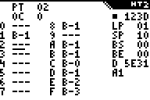Yes, I compose music on a calculator
When I was a real young person (as opposed to a, humm humm, young 40 years old person), I created games on Casio and Texas Instruments calculators. That’s actually how I learned programming: I was technically in a school, but not to learn how to align bits, I was doing that by myself with the help of a few books dedicated to the topic of making games on TI machines (it was a thing in the mid-90s).
My most advanced creation is a Zelda clone called NepQuest, short name for Nepemy’s Quest, Nepemy being the hero. I copied the graphics from a magazine featuring enlarged screenshots of Link’s Awakening for Game Boy using pen & paper, turning the black and white grid to pairs of X,Y integers. That was a painful process, but I got there:

All this took place between 1996 and 2000, I was 20 years old when NepQuest got completed. Oh, the text is in French, because I am.
Not long ago, maybe 2 months back, I saw a post on Instagram: someone was making music on their Texas Instruments TI-82. I froze, then started to sweat heavily, just before racing to eBay. I had to join the party. I’m in no way a musician, but I nevertheless composed a few Dance/Techno/Trance tracks in the late 90s/early 2000s. True, I was and still am a geek, no girlfriend, tons of computers and electronic toys, into role playing games, fond of chiptune, the real deal.
Our world being full of geeks, there had to be one to create a tool such as HoustonTracker 2:
Such a beauty, so clean, so simple, so…so…so much of something I need in my life. Even better than LSDJ maybe. Hey, I said maybe.
The tools you need
In terms of hardware, just get a cheap 4th hand Texas Instruments calculator on eBay or anything equivalent. I got two, two calculators, a dark grey TI-83 for 17 $AUD and a transparent crystal blue TI-83 Plus for 23 $AUD. They don’t exactly look like they were made yesterday, actually they are more in the « damaged goods » category, but who cares ? Not me.
Also, don’t forget to get yourself a sweet sweet TI-Graph Silverlink cable (23 more $AUD) and a 2.5mm male to 3.5mm female jack adapter so you can plug earphones on your calculator.
The software side of things won’t cost you anything: TiLP & HoustonTracker 2 are both free. The setup step was a bit chaotic for me, but nothing too bad. Just read the doc (the one for HT2 is very good), Google whatever question you might have and be patient. I will probably write a tutorial in the future, just wait for it if you don’t feel like going on that journey by yourself.
What is it like to blip blop ?
Well, you’ve got to like typing on a calculator keyboard:

The A, B, C…G keys are notes, like on a piano. You press Alpha, then a note to place a sharp. It’s a bit like playing music with a spreadsheet like Microsoft Excel: you have 3 columns for notes plus one column dedicated to drums. The columns have several rows that are read in sequence from top to bottom at a user-defined BPM. Remember the mechanical piano in the TV show Westworld ? Each hole in the paper roll triggers a note:

What happens on the calculator is very similar:

The lines numbered from 00 to 09 verticaly on the left are read one-by-one while the numbers aligned horizontaly (00 02 01 00) represent blocks of notes and drum sounds. These blocks are called patterns. What do they look like ? Notes patterns contain 16 lines numbered in hexadecimal, which is why they go like 0, 1, 2…F, where F is 15 (true, geeks like to count starting from 0 and they also like using weird notations).
B-0, B-1, B-2 are notes, the number after the dash being the octave to play it on:

So that was a note pattern. I also mentionned drums, and guess what, drum patterns look different:

Again, we have 16 lines numbered from 0 to F (you will get used to that), but the « notes » are not the same. The leftmost digit is the kind of drum sound to play, there are 15 of them. The 3 rightmost numbers are effects you can apply to note channels. They change the way notes are played and make them sound very different from what they should normally sound like. It’s very useful to create a wide variety of otherworldly sounds so that your tracks don’t all sound the same.
Where do we go from there ?
Stay tuned, I will publish articles on a regular basis. I’m still very new to the HT2 game, I have a lot to learn. I will share my coolest findings here with you. See you soon !



